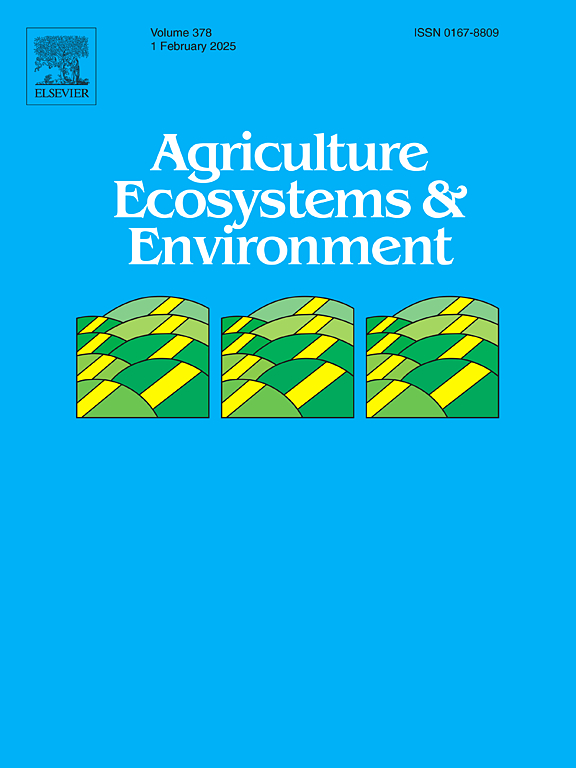Logging intensity and biome type mediate the effects of forest logging on soil greenhouse gas emissions
IF 6.4
1区 农林科学
Q1 AGRICULTURE, MULTIDISCIPLINARY
引用次数: 0
Abstract
Understanding the impacts of forest logging on soil greenhouse gas (GHG) emissions is crucial for developing sustainable forest management practices and climate change mitigation strategies. However, the directional patterns, magnitude of change, and mechanistic drivers underlying logging-induced alterations in soil GHG fluxes remain insufficiently characterized. Through a global meta-analysis incorporating 641 paired observations from 163 peer-reviewed studies, we demonstrated that forest logging significantly enhanced soil methane (CH4) and nitrous oxide (N2O) fluxes (mean effect sizes = 1.81 and 0.75, respectively), while exerting no substantial overall influence on carbon dioxide (CO2) flux (mean effect size = −0.09, 95 % CI: −0.44 – 0.25). Biome-specific analysis revealed pronounced spatial heterogeneity, with arctic/boreal ecosystems exhibiting greater responsiveness to logging impacts compared to tropical/subtropical regions. These emission shifts were mechanistically associated with logging-induced modifications in soil thermal regimes, hydrological conditions, and initial carbon-nitrogen content. Notably, soil CH4 and CO2 fluxes changes showed significant relationships with logging intensity (2.75 – 100 % basal area removal; P < 0.05), whereas time since logging (0.1 – 96 years) generally exhibited non-significant correlations with all measured GHG emissions (P > 0.05). Moreover, our meta-regression analysis identified thresholds governing the global-scale responses of GHG emissions to both logging intensity and temporal recovery. These insights advance the mechanistic understanding of disturbance-mediated biogeochemical processes and provide empirical foundations for optimizing silvicultural interventions to achieve climate-adaptive forestry objectives.
森林采伐强度和生物群落类型对土壤温室气体排放的影响具有中介作用
了解森林采伐对土壤温室气体(GHG)排放的影响对于制定可持续森林管理做法和减缓气候变化战略至关重要。然而,测井引起的土壤温室气体通量变化的方向模式、变化幅度和机制驱动因素仍然没有充分表征。通过一项包含163项同行评审研究的641对观测结果的全球荟萃分析,我们证明森林采伐显著提高了土壤甲烷(CH4)和氧化亚氮(N2O)通量(平均效应值分别为1.81和0.75),而对二氧化碳(CO2)通量没有实质性的总体影响(平均效应值= - 0.09,95 % CI: - 0.44 - 0.25)。生物群落特异性分析显示出明显的空间异质性,与热带/亚热带地区相比,北极/北方生态系统对伐木影响的响应更大。这些排放变化与采伐引起的土壤热状态、水文条件和初始碳氮含量的变化有机制联系。值得注意的是,土壤CH4和CO2通量变化与采伐强度呈显著相关(2.75 ~ 100 %基带面积去除;P <; 0.05),而自伐木以来的时间(0.1 - 96年)通常与所有测量的温室气体排放表现出不显著的相关性(P <; 0.05)。此外,我们的元回归分析确定了控制温室气体排放对伐木强度和时间恢复的全球尺度响应的阈值。这些见解促进了对干扰介导的生物地球化学过程的机制理解,并为优化造林干预措施以实现气候适应性林业目标提供了经验基础。
本文章由计算机程序翻译,如有差异,请以英文原文为准。
求助全文
约1分钟内获得全文
求助全文
来源期刊

Agriculture, Ecosystems & Environment
环境科学-环境科学
CiteScore
11.70
自引率
9.10%
发文量
392
审稿时长
26 days
期刊介绍:
Agriculture, Ecosystems and Environment publishes scientific articles dealing with the interface between agroecosystems and the natural environment, specifically how agriculture influences the environment and how changes in that environment impact agroecosystems. Preference is given to papers from experimental and observational research at the field, system or landscape level, from studies that enhance our understanding of processes using data-based biophysical modelling, and papers that bridge scientific disciplines and integrate knowledge. All papers should be placed in an international or wide comparative context.
 求助内容:
求助内容: 应助结果提醒方式:
应助结果提醒方式:


